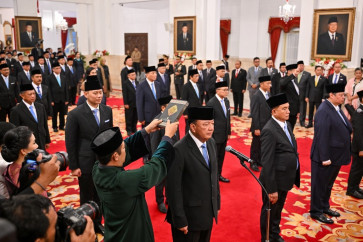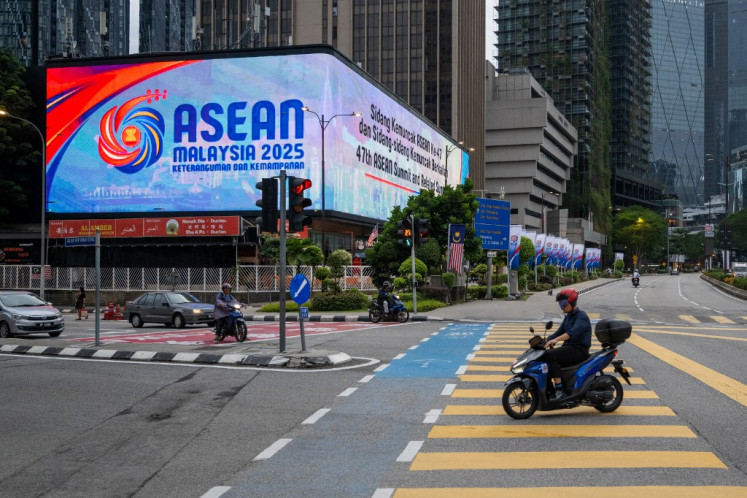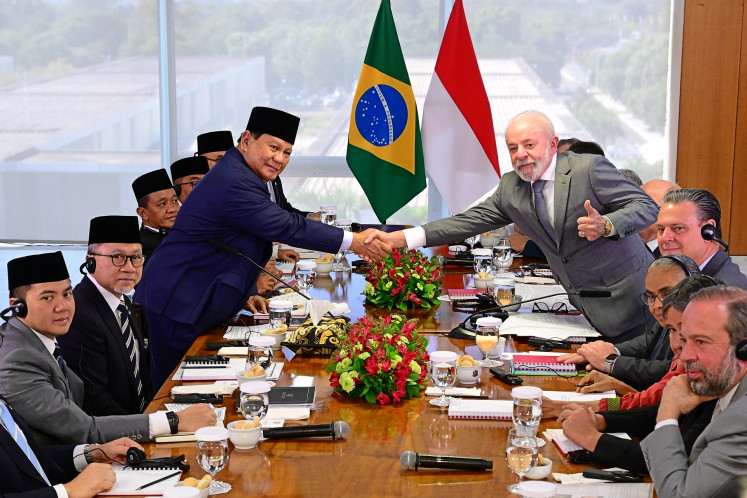Popular Reads
Top Results
Can't find what you're looking for?
View all search resultsPopular Reads
Top Results
Can't find what you're looking for?
View all search resultsHoning talent in classrooms of color
Bringing the arts back: SOTA students are encouraged to develop their artistic talents in visual arts, namely painting
Change text size
Gift Premium Articles
to Anyone
B
span class="caption" style="width: 399px;">Bringing the arts back: SOTA students are encouraged to develop their artistic talents in visual arts, namely painting. The School of the Arts Singapore (SOTA), has shown how the country is moving toward a point where arts are placed on the same footing as other disciplines. Courtesy of the School of the Arts of Singapore
To dedicate one’s life to art is often seen to dedicate one’s life to disappointment and suffering. Public recognition is a rarity, so a true artist is often not without a sense of burden.
Perhaps, that’s why we can still find many parents shaking their heads in disagreement when their children express a desire to study arts. Most of them – if not all – tend to want their children to study more “serious” subjects such as science and mathematics, something that seems to offer a brighter future.
But in finding out why Singapore opened its first national pre-tertiary arts school more than a year ago, we glean some insights into how arts can actually contribute to a multicultural society in the modern world.
The School of the Arts Singapore, or more simply SOTA, has shown how the country is moving toward a point where arts are placed on the same footing as other disciplines, like the aforementioned science and mathematics, in terms of their contribution to development.
“We all know how Singapore always focuses on mathematics, science, technology and all,” says Dr. Yap Meen Sheng, the school’s vice principal of development.
“But you see, the creative industry is now starting to be considered a new engine, so we see it as important to nurture the youth in the arts as well create professionals and individuals who are passionate in arts.”
The creative industry has been predicted by many futurists, including Alvin Toffler, to replace the golden era of information technology, becoming a business trend in the future.
Because the creative industry is undeniably strongly linked to arts, as Yap says, creating that critical mind of arts should be honed as early as possible in a formal education institution.
“Compared to other countries, Singapore is very young,” Yap says.
“We don’t have a cultural heritage, that’s why we depend on our children. The Singaporean government really depends on education because the only resources we have are human.”
And when it comes to education, of course, it’s all about leaving the decision to parents. But in the case of Singapore, luckily, the parents have been as excited as their children when sending their kids to study the arts formally.
“Parents are very supporting; it’s surprising that the mind-set of Singapore parents has changed,” says Arene Koh, the school’s assistant vice principal.
“They accept the fact that their children have a passion for arts. They’re happy to see their children are happy as the children study at an arts school.”
Future stars: The School of the Arts Singapore (SOTA), which opened in early 2008, is opened to young talents in four arts disciplines: visual arts, dance, theater and music. Courtesy of the School of the Arts of Singapore
Dance student Poh Hian, for instance, is one of those happy students who has no regrets about taking an unconventional route.
“School life here is great and the culture is fantastic,” says the 16-year-old who chose SOTA instead of accepting a place at the Raffles Junior College.
“Through anatomy and kinesiology lessons, I’ve had an increased understanding of my body, how to take care of it and how to use it well.”
Since SOTA was opened in early 2008 by the Singaporean Ministry of Information, Communications and Arts, the school has seen a big response to its unique style of education. Offering a one-of-a-kind six-year integrated arts and academic curriculum for youths aged 13 to 18, the school teaches students how to see the connections between arts and other subjects like biology, chemistry and mathematics.
“In SOTA, it’s all about a whole brain approach, not about the left brain or the right brain, as some people say that the creative arts people have more of a one-sided brain,” Yap says.
“Some people think when someone is good in arts then he’s not good in reasoning and logic. We want to prove it’s not true.”
And the school’s paradigm proves right when their students qualify for the Singapore Mathematics Olympiad.
As an integrated arts institution, Koh says, SOTA is opened to young talents in four arts disciplines: visual arts, dance, theater and music. Students who wish to study there must attend the Talent Academy, a selection platform that includes live auditions, personal interviews and portfolio reviews with a panel of experienced educators and arts specialists. Although the students focus on their preferred disciplines, they are also exposed to the basics of all four arts disciplines and continue to adopt a cross-disciplinary approach even as they develop in their chosen discipline.
“We also put students from different disciplines into one class, so they can also exchange ideas and can learn from each other,” Koh says.
The model for SOTA is a Laboratory of Creativity, where research is done, creative work made, and the results of this work communicated – between students, between teachers and students, between the school and the wider community. In SOTA, as Koh points out, the education is tailored to the students, and not the other way around. Once, a talented student in tabla (a popular Indian percussion instrument) was accepted, although the school had no tabla teacher back then.
“This student is very talented in tabla, so we looked for a teacher,” he says.
“We believe that arts are very much customized; it’s not like a mass production, so we find the right teacher to match the students.”
After all, he adds, “Students come here with high passion and motivation, so we value each of them.”
Learning arts in the school is also not only about performing or doing visual arts. In theater, for instance, it’s not only about acting, dancing and singing; the students learn about the full works behind the stage.
“Sometimes we see the [school’s] very good actors, actresses and scriptwriters carrying chairs and tables,” Koh says.
“[That’s] because we want them to learn to get everybody working together as a team to get a good production going.
“So it’s not just some experts or some good actors going up there and playing, and the end of they don’t care what happens.”
SOTA receives 200 students a year, with an average class size of 20 to 25 students each. Twenty percent of the school’s placement is allocated to foreign students, says Koh, in line with government regulations.
“Forty percent of our students study visual arts, because it has more career options like in architecture and graphic design,” he says.
He adds students from the school graduate after six years with an International Baccalaureate (IB) Diploma, which qualifies them for entry into local and overseas universities to pursue both arts and non-arts degrees. Surprisingly, Koh says the school doesn’t really expect their students to continue their studies to higher arts institutions; they only target 5 to 10 percent of students to continue studying arts in academies or universities.
“We expect the rest of the students to pursue an education in law, medicine, journalism … well anything,” he says.
That’s because, he adds, in the first place SOTA aims to shape students’ minds and broaden their knowledge using “the arts approach”. So at the end of the day, they will not just be artists, but also creative professionals and individuals in all fields.
“What we believe is that although they don’t turn out as artists, at least arts have shaped their mind and broadened their knowledge,” Koh says.
“So you know, one might say ‘I can be a good lawyer, but I’m also a good pianist.’”
Yap nods, saying, “Our students might not become performers, but someday they will become the audience, and that would be an educated audience of the arts.”











